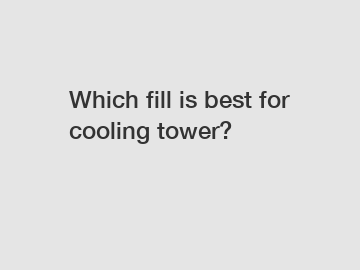Which fill is best for cooling tower?
Which Fill is Best for Cooling Tower?
Cooling towers play a crucial role in many industrial processes where heat dissipation is required. These towers transfer excess heat from buildings or industrial equipment to the atmosphere, ensuring optimal performance and preventing overheating. One critical component in cooling towers is the fill, which provides a large surface area for efficient heat exchange between water and air. With various fill options available, it is important to select the best fill for optimal cooling tower performance and energy efficiency. In this article, we will explore the different types of fills commonly used in cooling towers and discuss their advantages and disadvantages.
Film Fill: Efficient and Reliable.

Film fill is one of the most commonly used types of fills in cooling towers. It consists of closely spaced, vertically oriented sheets or modules that allow water to form thin flowing films. This design provides a large surface area for contact between water and air, enhancing heat transfer efficiency. The thin film of water helps to maximize evaporation, effectively cooling the water flowing through the tower.
Film fill offers numerous benefits, including high thermal performance, low pressure drop, and resistance to fouling. It is particularly effective in applications where water quality is a concern since it can handle a wide range of water conditions. Furthermore, film fill is durable and requires minimal maintenance, ensuring long-term reliability and cost-effectiveness.
Splash Fill: Economical and Versatile.
Splash fill, also known as random pack fill, is another popular type of fill used in cooling towers. It consists of irregularly shaped plastic or PVC pieces that break the water flow into small droplets. These droplets create a large surface area, facilitating efficient heat transfer between water and air.
Splash fill is known for its simplicity and cost-effectiveness. It is easy to install and does not require precise alignment or spacing. Additionally, splash fill is versatile and can handle variations in water flow rates without sacrificing performance. However, its main drawback is its susceptibility to fouling. The irregular shape of the fill pieces can accumulate debris and scale, reducing heat transfer efficiency over time.
Combined Fill: The Best of Both Worlds.
To overcome the limitations of individual fill types, some cooling towers use a combination of film fill and splash fill. This hybrid fill design aims to optimize heat transfer efficiency while minimizing maintenance requirements. By combining the advantages of film fill and splash fill, users can achieve a balance between performance and cost-effectiveness.
The selection of fill type should take into consideration various factors, including water quality, temperature, flow rates, maintenance requirements, and budget. Consulting with cooling tower experts and manufacturers can help determine the most suitable fill for a specific application.
Closing Paragraph:
In conclusion, choosing the right fill for a cooling tower is crucial for optimal performance and energy efficiency. Film fill offers excellent thermal performance and resistance to fouling, making it a popular choice. Splash fill, on the other hand, provides economical and versatile options but requires regular maintenance to avoid fouling. Ultimately, a combination of film fill and splash fill can be the best choice for balancing performance and cost-effectiveness in cooling tower applications. For expert advice and assistance in selecting the right fill for your cooling tower, please contact us.
Keywords: contact us.
Want more information on cooling tower function, plate settler clarifier, filter ceramic rings? Feel free to contact us.
121
0
0


Comments
All Comments (0)